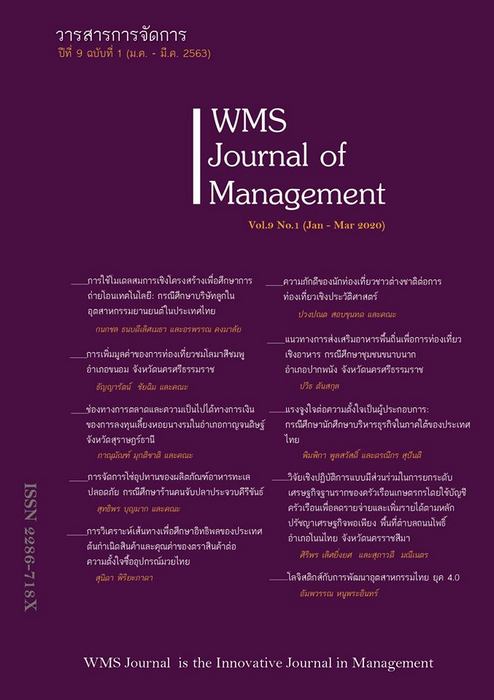Value Creation of Pink Dolphin Tourism Khanom District, Nakhon Si Thammarat Province
Main Article Content
Abstract
The purpose of this research are as follow; 1) Study the tourism management guidelines for watching pink dolphins in Khanom District, Nakhon Si Thammarat Province. 2) Study the characteristics of tourism in watching pink dolphins in Khanom District, Nakhon Si Thammarat Province. 3) Analyzing the willingness to pay of tourists. Dolphins in Khanom District, Nakhon Si Thammarat Province. Data are collected from the 300 samples of site tourists traveling to Khanom District Nakhon Si Thammarat Province. Then, the data are analyzed using choice modeling. The study found that most tourists come from nearby areas. The pink dolphin population and the knowledge of the pink dolphins are the main factors significantly affect the willingness to pay of tourism to see the pink dolphins at Khanom District, Nakhon Si Thammarat Province. Especially, increasing in knowledge of the pink dolphins for tourists visited at Khanom district Nakhon Sri Thammarat will encourage them to pay more by 380.81 baht per trip. Also, if the pink dolphin population increases, tourists are willing to pay more by 2,333.32 baht per trip. In addition, tourists also suggest to increase cleanliness around the tourist area. Therefore, communities and related agencies should focus on the enhancement of pink dolphins and set policies to promote knowledge for villagers who are engaged in tours, in order to bring the knowledge gained to the tourists who visit the pink dolphins. In addition, the government should allocate budget for the care of pink dolphins directly, such as budgeting for creating food sources for dolphins or budget for campaigning to properly see the correct dolphins to enhance the population of pink dolphins sustainably.
Article Details
References
Iswilanon, S. (1997). Natural resource and environmental economics: principles and theories Nonthaburi: Lertchai Printing.
Jamjirasai, S. (2015). Factors for decision making for purchasing durian in the eastern region of Thailand: A case study of consumers. (Master’s thesis, Kasetsart University).
Kongsompong, S. (2014). Value creation, project, development, managementfor senior management, consulting firm APM Group, Bangkok Press.
Office of the National Economic and Social Development Council. (2015). World tourism situation and trends in 2015. Retrieved from https://www.nesdb.go.th
Piriyapada, S. (2018). Tourists’ Willingnessto Payfor Low- Carbon Destination Management: A Case Studyof KoLan, Chonburi Province. Development economic, 12(2), 80-102
Preprachawong, U. (2013). Economic valuation of environmental resources. Bangkok: Paliving.
Sanglestsawai, S. (2006). Asseessing Consumer Preferences for Doikham Safe Vagetables in Bangkok A Choice Modeling Approach. (Master’s thesis, Kasetsart University).
Sirivirintarat, T. (2014). Evaluation of Irrwaddy Dolphin (Orcaella brevirostris) Watching Tourism Attributes of Bang Pakong Estuary, Chachoengsao Province. (Master’s thesis, Kasetsart University).
Sutthinanthachod, T. (2016). The Thai Tourist Satisfaction in Than Sadet – Ko Pha-ngan National Park Surat Thani Province (Master’s thesis, Hatyai University).


